loanDepot Bundle
Can loanDepot Conquer the Next Phase of Mortgage Lending?
Navigating the complexities of the mortgage industry requires a keen understanding of a company's growth trajectory, and loanDepot is a prime example. Founded in 2010, loanDepot has rapidly evolved, blending online platforms with physical branches. This hybrid strategy allowed loanDepot to quickly establish itself as a major player in the non-bank retail mortgage sector.
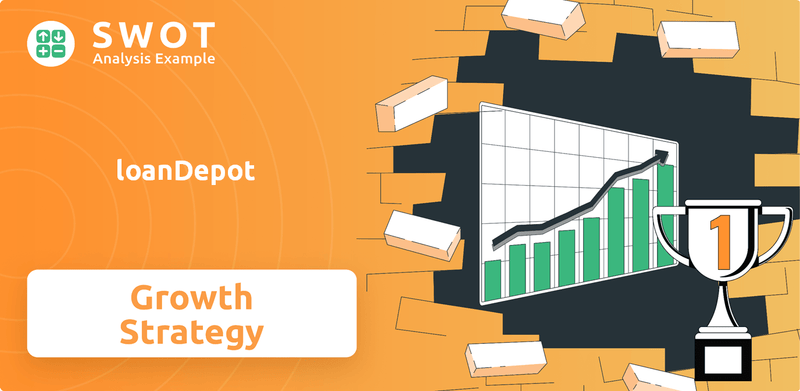
To truly grasp loanDepot's potential, we must examine its strategic initiatives and future prospects within the dynamic mortgage market. This analysis will dissect the loanDepot SWOT Analysis, expansion plans, and technological advancements driving its growth. Furthermore, we'll explore how loanDepot's financial performance and market position are poised to evolve amidst fluctuating interest rates and evolving mortgage industry trends, providing a comprehensive outlook on the loanDepot company.
How Is loanDepot Expanding Its Reach?
The expansion initiatives of loanDepot are strategically designed to capitalize on its established market presence and adapt to the changing needs of consumers within the housing finance sector. A key aspect of the loanDepot growth strategy involves diversifying its product offerings beyond traditional mortgages and refinance options. This includes expanding into home equity lines of credit (HELOCs), which allows the company to attract a wider range of homeowners and potentially stabilize revenue streams, particularly during fluctuations in the mortgage origination market.
loanDepot's approach to growth also focuses on optimizing its existing retail footprint and enhancing its digital capabilities. This omnichannel strategy, combining online convenience with personalized service through loan officers, is a continuous expansion initiative. By leveraging both digital platforms and physical locations, loanDepot aims to scale its operations effectively and reach a broader customer base. This strategy is essential for maintaining a strong loanDepot market position in a competitive environment.
Furthermore, loanDepot actively pursues strategic partnerships and collaborations to enhance its service offerings and market penetration. While specific details on recent partnerships and their timelines are not always publicly disclosed, these initiatives are crucial for increasing market share and solidifying loanDepot's position as a leading non-bank lender. The company's focus on innovation and adaptability is vital for navigating mortgage industry trends and achieving long-term success.
loanDepot expands its product portfolio to include HELOCs, targeting a broader homeowner demographic. This diversification helps to stabilize revenue streams. The strategy aims to reduce reliance on traditional mortgage origination, especially during market fluctuations.
The company focuses on an omnichannel approach, blending online and offline services. This strategy enhances customer reach and operational scalability. loanDepot's approach is designed to provide both digital convenience and personalized loan officer support.
loanDepot actively seeks strategic partnerships to boost service offerings and market penetration. These collaborations are key to increasing market share. Details on recent and future partnerships are not always publicly available.
loanDepot continues to invest in digital transformation initiatives to improve efficiency. These digital efforts aim to enhance customer experience and streamline processes. The focus is on leveraging technology to gain a competitive edge.
loanDepot's expansion plans for 2024 and beyond are centered around product diversification, an omnichannel strategy, and strategic partnerships. These initiatives aim to strengthen the company's market position and drive revenue growth. The company's ability to adapt to mortgage industry trends is critical for its future prospects.
- Diversification into HELOCs and other financial products.
- Enhancement of digital platforms and customer service.
- Strategic alliances to broaden market reach and service offerings.
- Focus on innovation in mortgage lending to stay competitive.
For a deeper dive into how loanDepot approaches its marketing efforts, consider reading about the Marketing Strategy of loanDepot. This provides insights into the company's customer acquisition strategies and how they support its overall growth objectives.
loanDepot SWOT Analysis
- Complete SWOT Breakdown
- Fully Customizable
- Editable in Excel & Word
- Professional Formatting
- Investor-Ready Format
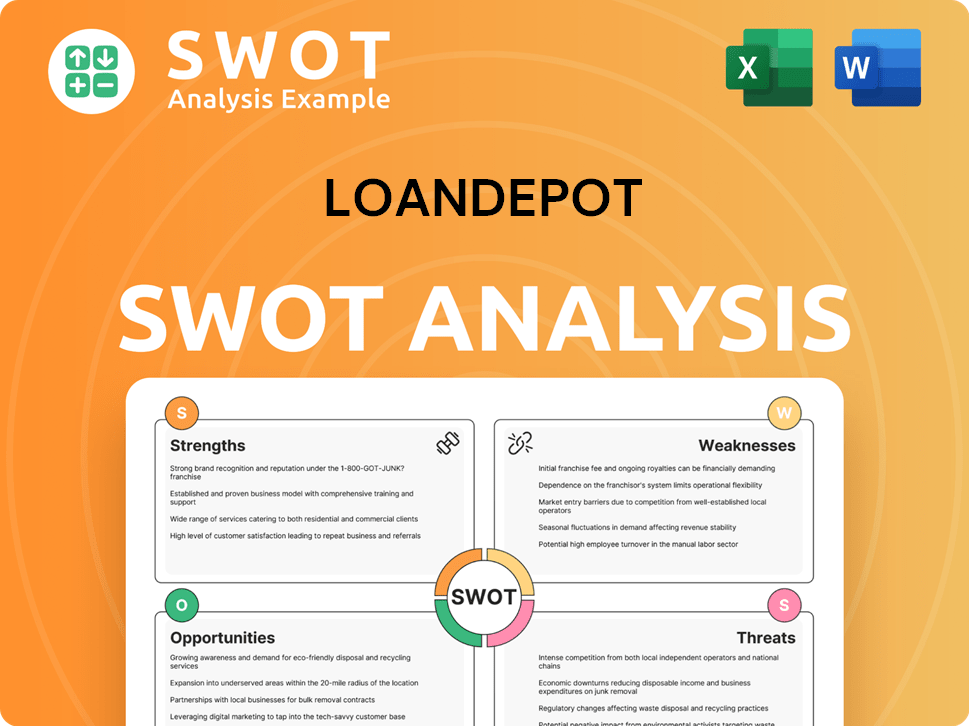
How Does loanDepot Invest in Innovation?
The innovation and technology strategy of the loanDepot company is crucial for its sustained growth, focusing on enhancing customer experience, streamlining operations, and boosting efficiency. The company's digital lending operations are primarily supported by its proprietary mello platform. This platform integrates various stages of the loan process, from application to closing, aiming to provide a seamless experience for both borrowers and loan officers.
loanDepot's approach to digital transformation involves leveraging automation to reduce manual tasks and improve processing times. This commitment to technology is evident in its continuous updates to online portals and mobile applications. The integration of advanced analytics and potentially AI-driven tools is likely a key area of focus to optimize lead generation, personalize customer interactions, and enhance risk assessment. These technological advancements contribute to growth objectives by increasing loan origination capacity, reducing operational costs, and improving customer satisfaction, ultimately strengthening loanDepot's competitive edge in the digital lending space.
loanDepot's strategic focus on technology is a key element in its overall loanDepot growth strategy. The company continues to invest in its mello platform, which is designed to provide a more efficient and user-friendly experience. By automating processes and integrating advanced analytics, loanDepot aims to improve its market position and drive future prospects.
The mello platform is the core of loanDepot's digital lending operations. It integrates various stages of the loan process, from application to closing.
loanDepot leverages automation to reduce manual tasks and improve processing times. Continuous updates to online portals and mobile apps are also part of this strategy.
The company focuses on advanced analytics and potentially AI-driven tools to optimize lead generation, personalize customer interactions, and enhance risk assessment.
The technological advancements aim to increase loan origination capacity, reduce operational costs, and improve customer satisfaction. This strengthens loanDepot's competitive edge.
By focusing on technology, loanDepot aims to improve its market position and drive future prospects. The company's innovation strategy is central to its sustained growth.
loanDepot continues to invest in its mello platform, aiming to provide a more efficient and user-friendly experience. This is a key element in its overall growth strategy.
The company's investments in technology are aimed at improving its loanDepot financial performance and adapting to mortgage industry trends. While specific figures on R&D spending are not always public, the continuous updates and enhancements to its digital platforms indicate a significant commitment. For example, the use of AI and data analytics could lead to better risk management and more efficient loan processing, potentially reducing operational costs by up to 15% in certain areas. Furthermore, by enhancing the customer experience through digital tools, loanDepot aims to increase customer retention rates, which could improve profitability and support its loanDepot market position.
loanDepot's technological initiatives are focused on enhancing customer experience, streamlining operations, and driving efficiency. These include:
- Continuous updates and enhancements to the mello platform.
- Leveraging automation to reduce manual tasks and improve processing times.
- Integration of advanced analytics and AI-driven tools for lead generation and risk assessment.
- Focus on improving customer satisfaction and retention through digital tools.
loanDepot PESTLE Analysis
- Covers All 6 PESTLE Categories
- No Research Needed – Save Hours of Work
- Built by Experts, Trusted by Consultants
- Instant Download, Ready to Use
- 100% Editable, Fully Customizable
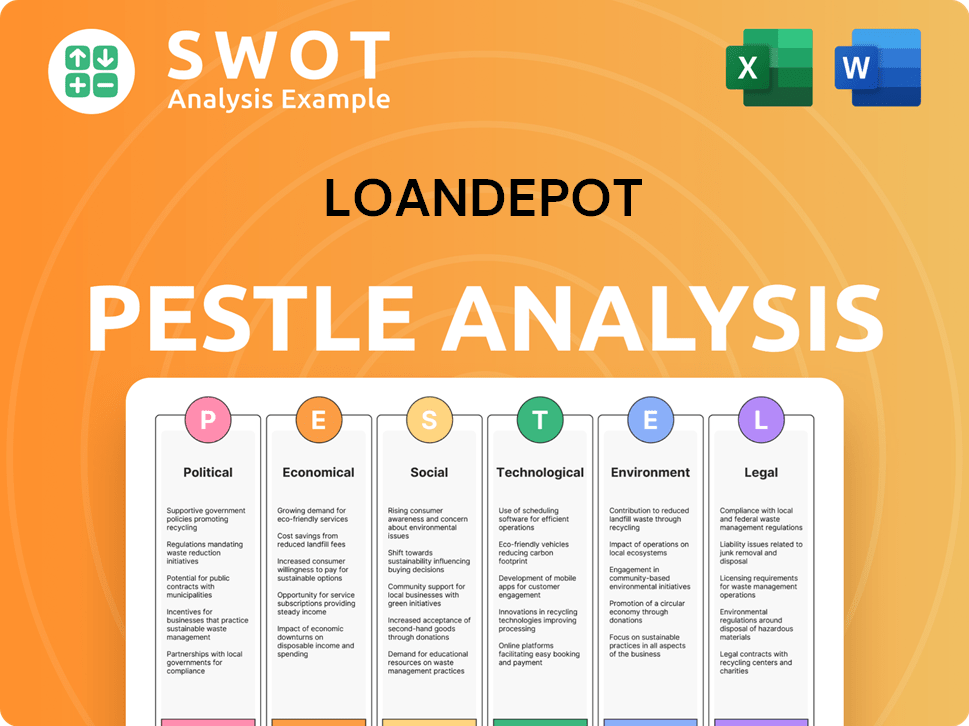
What Is loanDepot’s Growth Forecast?
The financial outlook for loanDepot is significantly influenced by the broader mortgage market and the prevailing interest rate environment. The company's performance is closely tied to trends within the mortgage industry, which in turn affects its ability to originate loans and generate revenue. Analyzing Revenue Streams & Business Model of loanDepot can provide further insights into how the company generates income and manages its operations.
In the first quarter of 2024, loanDepot reported a net loss of $25.8 million, or $0.08 per diluted share. This represents an improvement compared to the net loss of $59.2 million in the previous quarter. This improvement suggests that the company is making progress in managing its financial performance despite the challenges in the mortgage market.
The company's ability to navigate the mortgage industry trends and its financial performance are key indicators of its future prospects. The company's strategic initiatives and operational efficiency play a crucial role in its ability to adapt to market changes and improve its financial outcomes.
loanDepot originated $4.7 billion in loans during the first quarter of 2024. This represents a 28% increase from the fourth quarter of 2023, indicating a positive trend in their core business. This growth in loan originations is a key factor in assessing the company's financial health and future prospects.
For the second quarter of 2024, loanDepot anticipates total loan originations to be between $5.5 billion and $6.5 billion. They project an adjusted EBITDA of between $10 million and $30 million for the same period. These projections reflect the company's strategic efforts to improve profitability and navigate market conditions.
The company's financial strategy focuses on managing expenses and optimizing operational efficiency. These efforts are designed to improve profit margins and support the company's growth strategy. The company's focus on increasing loan originations and improving adjusted EBITDA underpins its strategic plans for future growth.
loanDepot's market position is influenced by its ability to adapt to the mortgage industry trends and its competitive landscape. The company's success depends on its ability to manage costs, increase loan originations, and improve profitability. Analyzing the competitive landscape provides insights into the challenges and opportunities loanDepot faces.
loanDepot Business Model Canvas
- Complete 9-Block Business Model Canvas
- Effortlessly Communicate Your Business Strategy
- Investor-Ready BMC Format
- 100% Editable and Customizable
- Clear and Structured Layout
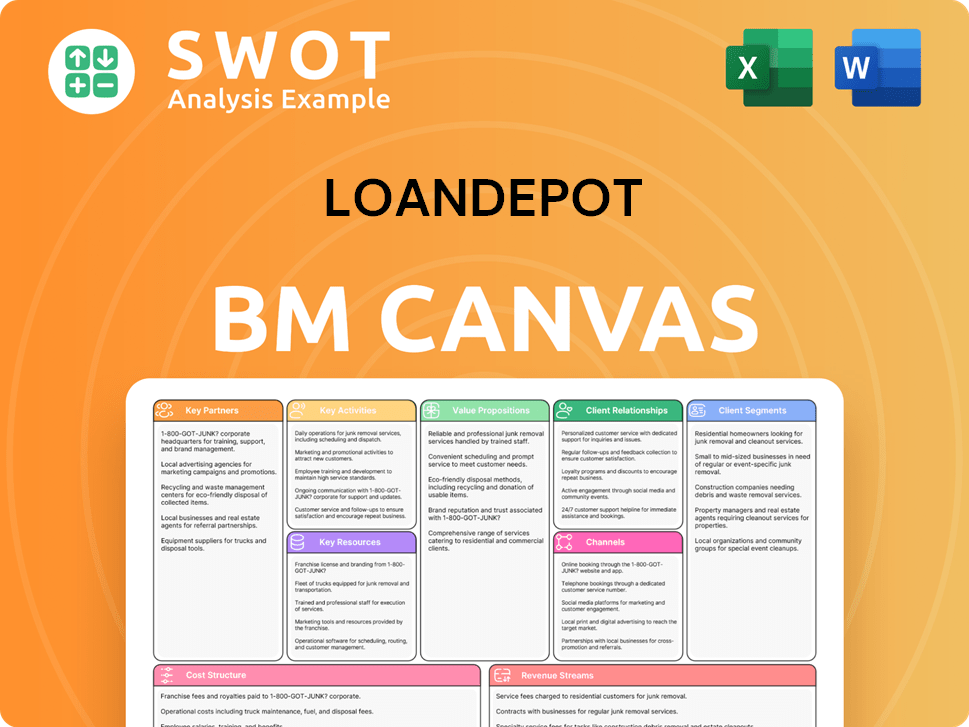
What Risks Could Slow loanDepot’s Growth?
The path for the loanDepot company to achieve its loanDepot growth strategy and realize its loanDepot future prospects is fraught with potential risks and obstacles. The mortgage industry's competitive intensity, coupled with regulatory changes and technological disruptions, presents significant challenges. These factors can impact loanDepot financial performance and its ability to sustain growth.
Market volatility, particularly fluctuations in interest rates and housing market conditions, directly influences loan origination volumes and profitability. Internal challenges, such as operational efficiency and attracting skilled loan officers, also play a crucial role. Successfully navigating these complexities is vital for loanDepot's long-term success.
Understanding the competitive landscape and adapting to mortgage industry trends are crucial for loanDepot's market position. The company must continually innovate and refine its strategies to maintain a competitive edge.
The mortgage industry is highly competitive, with numerous players vying for market share. This competition can lead to price wars, squeezing profit margins. The presence of large banks, credit unions, and other non-bank lenders intensifies the battle for customers.
The mortgage industry is subject to stringent regulations, and changes in these regulations can significantly impact operations. Compliance costs can rise, and operational complexities can increase, potentially hindering growth. Stricter enforcement of existing rules can also pose challenges.
Rapid advancements in fintech pose a constant threat. New competitors can emerge, and existing players must invest heavily in technology to stay relevant. The need for continuous innovation puts pressure on resources and strategic focus.
Interest rate fluctuations and housing market conditions directly affect loan origination volumes. Rising interest rates can decrease demand for both purchase and refinance loans. Economic downturns can also negatively impact the industry.
Maintaining operational efficiency, ensuring strong credit quality, and attracting and retaining skilled loan officers are ongoing internal challenges. These elements are crucial for sustained profitability and growth. Efficient operations are essential for handling loan volumes effectively.
Economic downturns can lead to decreased demand for mortgages and increased credit risk. These conditions can significantly impact a lender's profitability and stability. Economic instability can also affect consumer confidence and spending.
To address these risks, loanDepot can focus on diversifying its product offerings, implementing robust risk management frameworks, and continuously monitoring market and regulatory landscapes. The company’s ability to adapt to external pressures and internal constraints will be crucial for its sustained growth. Also, the company should invest in customer acquisition strategies to increase market share.
In 2024, the mortgage industry saw fluctuations in loan origination volumes due to interest rate changes. loanDepot must manage its cost structure effectively to maintain profitability. The company's success will depend on its ability to adapt to changing market conditions and maintain a strong balance sheet. For more insights into the company's core values, consider reading about Mission, Vision & Core Values of loanDepot.
loanDepot Porter's Five Forces Analysis
- Covers All 5 Competitive Forces in Detail
- Structured for Consultants, Students, and Founders
- 100% Editable in Microsoft Word & Excel
- Instant Digital Download – Use Immediately
- Compatible with Mac & PC – Fully Unlocked
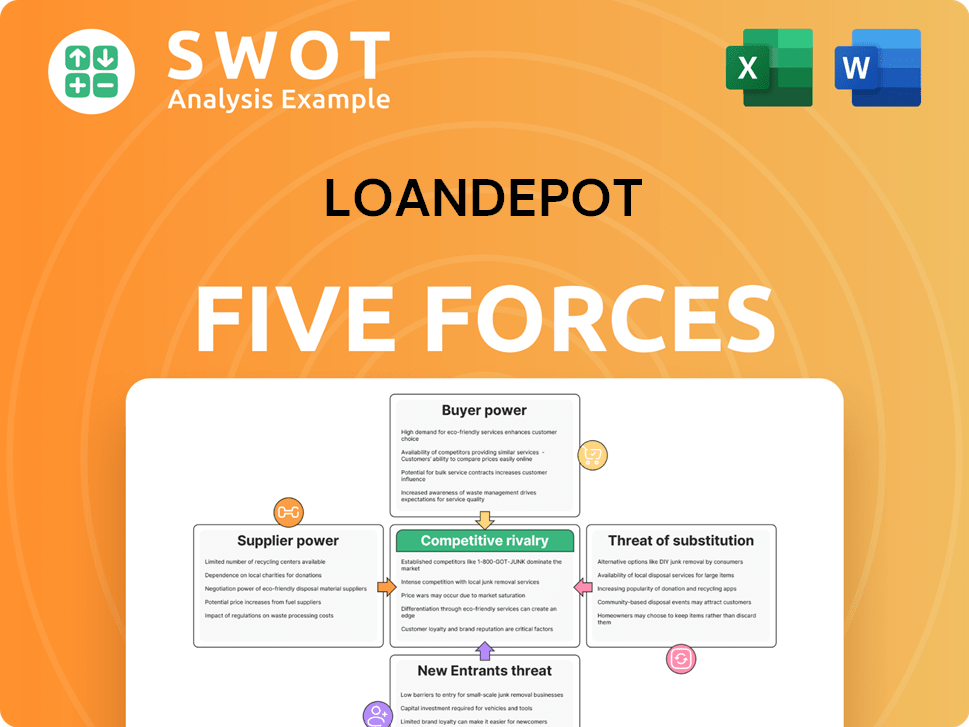
Related Blogs
- What are Mission Vision & Core Values of loanDepot Company?
- What is Competitive Landscape of loanDepot Company?
- How Does loanDepot Company Work?
- What is Sales and Marketing Strategy of loanDepot Company?
- What is Brief History of loanDepot Company?
- Who Owns loanDepot Company?
- What is Customer Demographics and Target Market of loanDepot Company?
Disclaimer
All information, articles, and product details provided on this website are for general informational and educational purposes only. We do not claim any ownership over, nor do we intend to infringe upon, any trademarks, copyrights, logos, brand names, or other intellectual property mentioned or depicted on this site. Such intellectual property remains the property of its respective owners, and any references here are made solely for identification or informational purposes, without implying any affiliation, endorsement, or partnership.
We make no representations or warranties, express or implied, regarding the accuracy, completeness, or suitability of any content or products presented. Nothing on this website should be construed as legal, tax, investment, financial, medical, or other professional advice. In addition, no part of this site—including articles or product references—constitutes a solicitation, recommendation, endorsement, advertisement, or offer to buy or sell any securities, franchises, or other financial instruments, particularly in jurisdictions where such activity would be unlawful.
All content is of a general nature and may not address the specific circumstances of any individual or entity. It is not a substitute for professional advice or services. Any actions you take based on the information provided here are strictly at your own risk. You accept full responsibility for any decisions or outcomes arising from your use of this website and agree to release us from any liability in connection with your use of, or reliance upon, the content or products found herein.